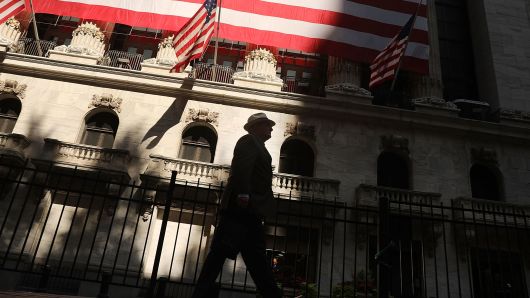
Rising bond yields have unnerved the stock market, and they could continue to be a source of volatility in coming weeks, as the Treasury market faces the challenges of growing U.S. Treasury debt supply and a ballooning U.S. budget deficit.
The 10-year Treasury yield climbed to a new seven-year high of 3.26 percent early Tuesday, after trading below 3 percent just a month ago. In that time, the S&P 500 has lost 1.2 percent. The 10-year on Tuesday later backed down from its highs, but it has now punctured 3.25 percent, a key level a number of strategists had targeted for year-end.
“I think we’re in no man’s land. I think it could go to 3.50 or 3.75 on really good news, good economic news, good global news, or if trade tensions go down,” said George Goncalves, head of fixed income strategy at Nomura. Next up for the market is inflation data — producer price inflation data Wednesday and the consumer price index Thursday.
Election talk is also affecting the rates market, which has been expecting Democrats to take the House and the GOP to hold the Senate. Goncalves said if there were a surprise Republican sweep of Congress, that could also cause yields to rise, as the GOP would be expected to consider more tax cuts and therefore larger deficits.
Bond sales this week will show whether investors are willing to buy at these higher levels. The Treasury is auctioning about $230 billion in 3- and 10-year notes and 30-year bonds Wednesday and Thursday.
Several strategists interviewed by CNBC expect the 10-year yield to move above the current level but not dramatically higher through the balance of the year.
“3.5 percent can’t be ruled out in any way, but I’m just not convinced growth and expectations are going to increase it to near 4 percent,” said Mark Cabana, head of U.S. short rate strategy at Bank of America Merrill Lynch.
The benchmark 10-year yield is widely watched, and the latest catalyst for the move higher was the hawkish comment last week from Fed Chairman Jerome Powell, who indicated the Fed is far from done raising interest rates. The 10-year is the rate that influences many business and consumer loans, including home mortgages, but it also weighs on the psyche of the stock market when its moves are rapid or abrupt.
“We’re here, in my opinion, primarily because Powell started talking about moving [rates] above neutral,” said Jim Caron, portfolio manager at Morgan Stanley Investment Management. “The markets are still adjusting.”
He added December is a time for Treasury yields to rise, because people are positioning portfolios for the end of the year.
Any move up in yield will get the attention of the stock market. Bank of America Merrill Lynch stock strategists said that at 5 percent, the 10-year yieldis at a breakpoint where investors would switch to favoring bonds over stocks. However, Credit Suisse chief U.S. market strategist Jonathan Golub said a better level to watch is 3.5 percent, since below that level is still a positive for stocks and above it yields become a challenge.
Analysts disagree on what level 10-year would be a problem for stocks, but they mostly agree the market is more vulnerable to a quick move in rates as opposed to a steady climb higher.
“Next year, we think rates will stabilize around these levels. We’re just looking for some clarity on what happens postelection and what happens with fiscal policy that will be key determinants thereafter. I would be biased thinking rates will stay around this level,” Cabana said.
But Goncalves said it is events later in the month that could really affect the markets and drive the 10-year above 3.25, his year-end target. That would include the Treasury’s announcement Oct. 31 of its refunding requirements, meaning bigger Treasury auctions to pay for the rising U.S. deficit.
He notes that the last week of October is also when an estimated $34 billion in securities will be rolling off the Fed’s balance sheet, the largest reduction year to date, and that could also pressure rates.
The end of the month is normally when investors adjust their portfolio positioning. This year, it’s also a week away from the midterm elections.
Goncalves said that perfect storm of events could put rates at their highs for the year, but Caron said the midterms may be a time when investors seek safety in Treasurys. Yields move opposite to prices.
“I think there’s going to be a lot of people taking chips off the table ahead of that,” he said.
Caron said the market should become increasingly focused on supply. “We know it’s no secret the deficit is going up. Everyone has a heightened sense of awareness,” Caron said. “What’s also interesting is the CBO [Congressional Budget Office] has a slower trajectory of growth that was priced in as a baseline and we’re doing better than that so maybe the deficit won’t go up as much as people think.”
Cabana said he expects a budget deficit of $825 billion this year and $1 trillion next year.
“I expect that things will stabilize a little bit around these levels. We’re seeing a little bit of that today. The market is in the process of repricing growth expectations, repricing Fed policy. I would think that we’re focusing a bit more on supply and how elevated that’s going to be. There are themes, like a lack of long-end buyers. I think they will jump in,” said Cabana. He said the next technical levels to watch on the 10-year are 3.33 and 3.45 percent.




























